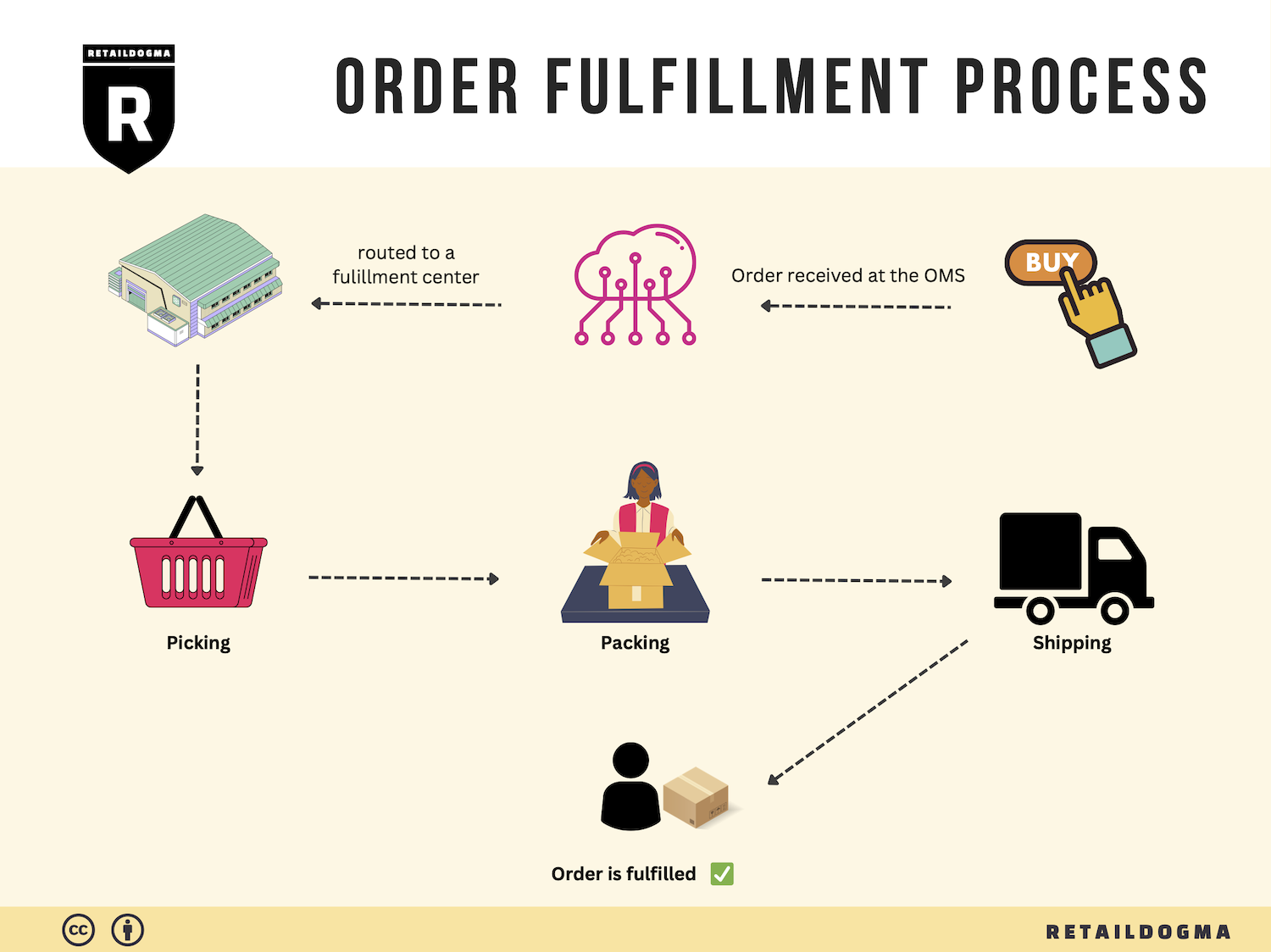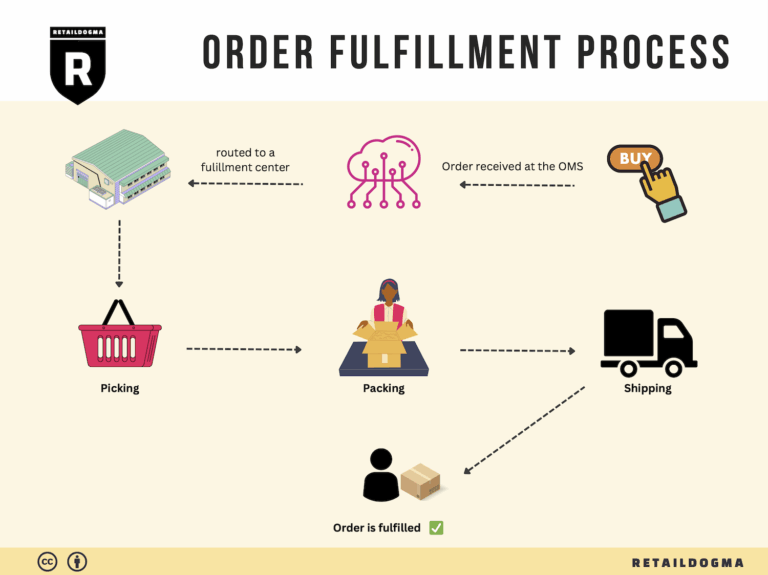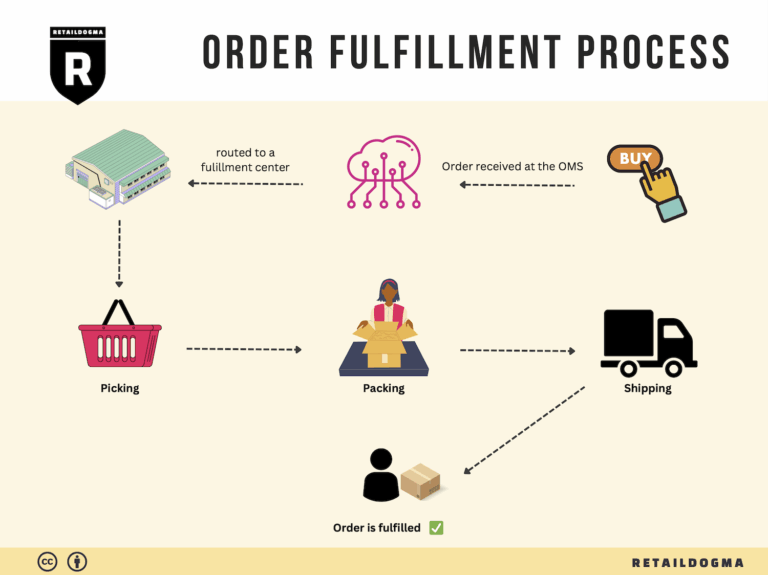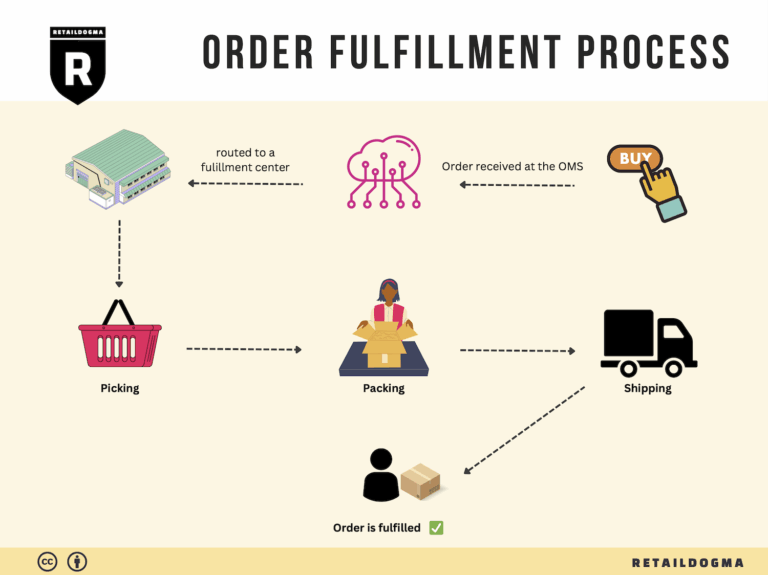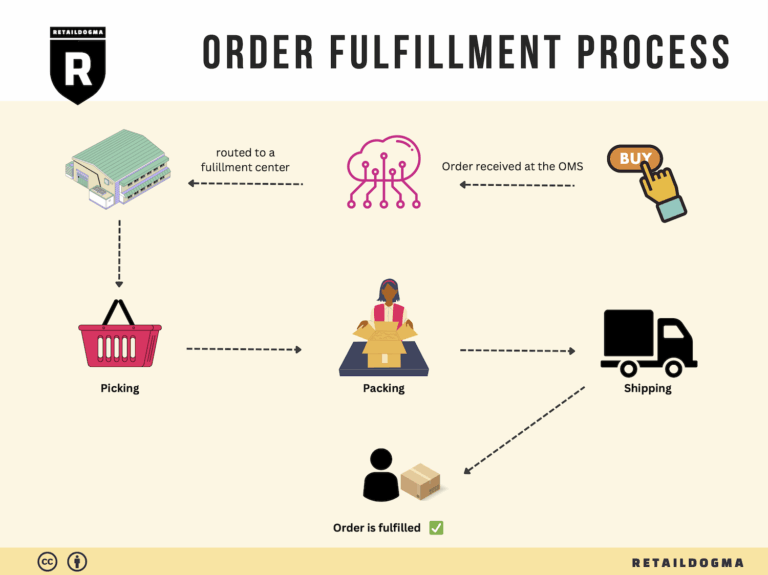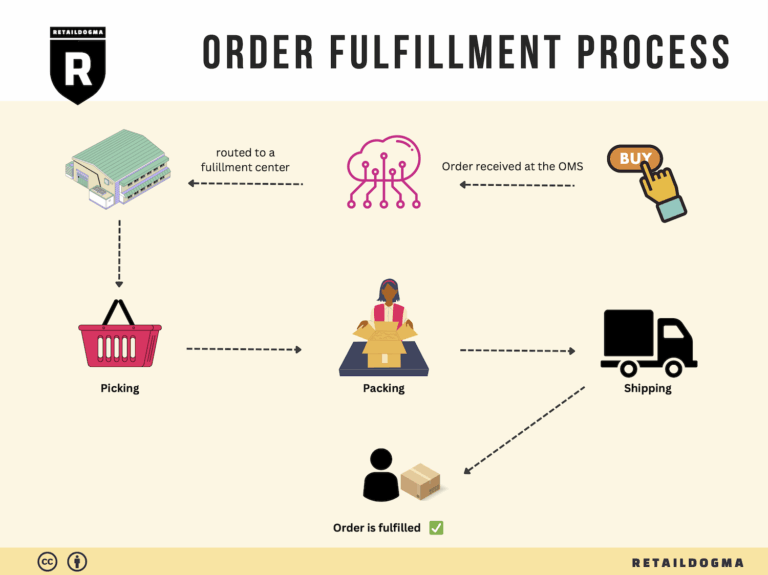What Is A Fulfillment Center? A Complete Guide (2025)
What is E-commerce Fulfillment? An Introduction for Growing Businesses
Understanding E-commerce Fulfillment: A Guide for Growing Businesses
As an e-commerce business owner, you may often find yourself overwhelmed by the complexities of packing and shipping orders. The excitement of scaling your online store can quickly turn into stress when faced with the logistics of getting your products to customers efficiently. This is where e-commerce fulfillment comes into play—it’s the backbone of your operations, encompassing everything from inventory management to the final delivery of products.
In simple terms, fulfillment is the process of preparing and delivering products to your customers. It involves various steps, including receiving inventory, storing it, processing orders, packing items, and shipping them out. For growing businesses, mastering this process is crucial not only for maintaining customer satisfaction but also for scaling operations effectively.
This guide aims to demystify e-commerce fulfillment, providing insights into the different models available, such as Third-Party Logistics (3PL) and Fulfillment by Amazon (FBA). We will explore core fulfillment services, including inventory management, order processing, and shipping solutions. Understanding these components will help you identify the best fit for your business needs.
Choosing the right fulfillment partner can significantly impact your bottom line. We’ll discuss key factors to consider when evaluating potential partners, including their technology, capacity, and service offerings. Additionally, we will cover pricing structures, helping you navigate the costs associated with different fulfillment options.
Our goal is to empower you with the knowledge and tools necessary to make informed decisions about your logistics strategy. By the end of this guide, you will be equipped to streamline your fulfillment processes, reduce operational headaches, and ultimately enhance your customer experience. Whether you’re just starting or looking to scale, understanding e-commerce fulfillment is essential to your success in the digital marketplace.
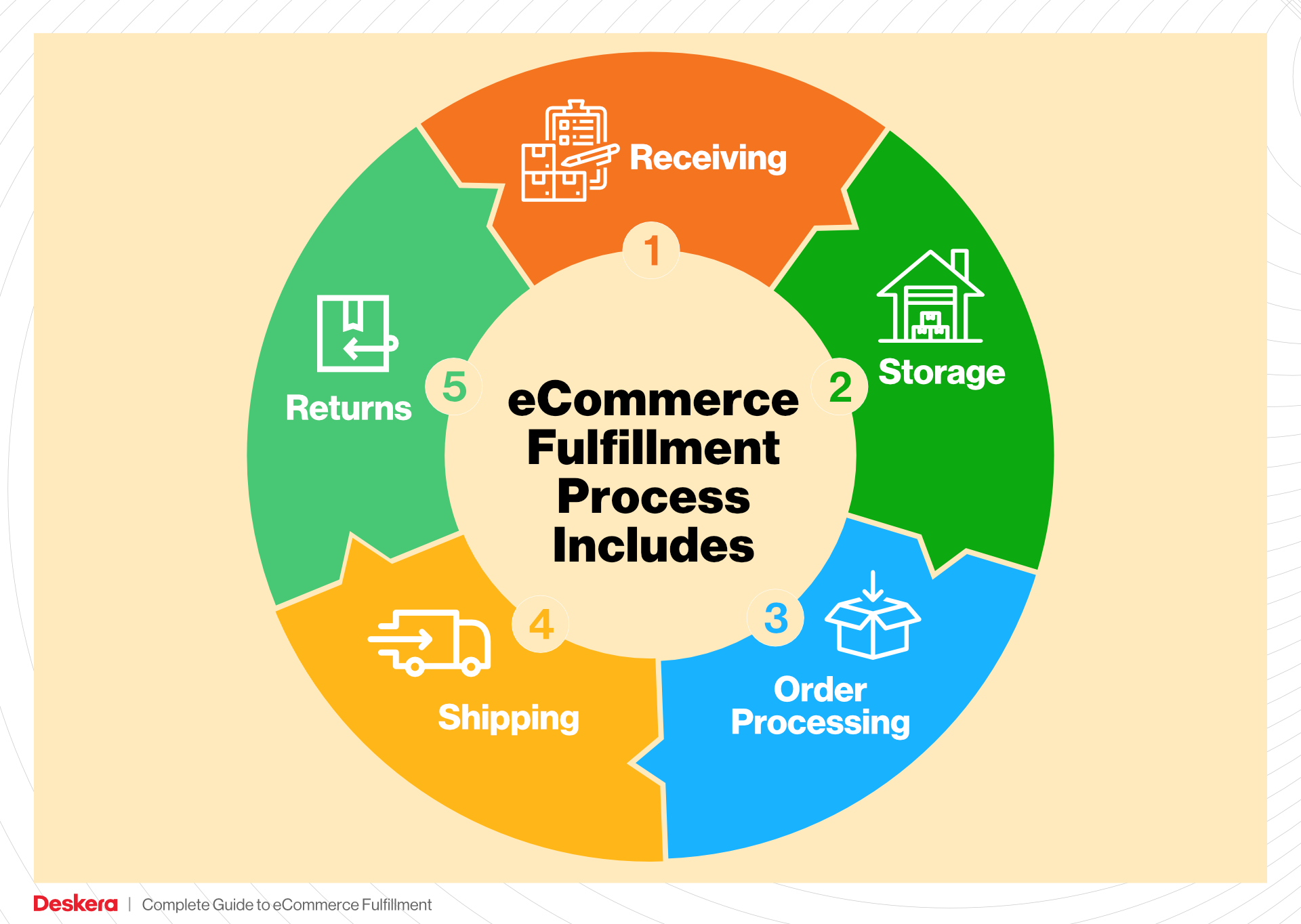
What You’ll Learn In This Guide
- What is E-commerce Fulfillment? An Introduction for Growing Businesses
- The Order Fulfillment Process: From ‘Buy’ Button to Customer’s Door
- Comparing Fulfillment Models: In-House vs. 3PL vs. Dropshipping
- A Deep Dive into Amazon FBA: Pros, Cons, and Who It’s For
- Core Services Offered by Fulfillment Centers
- How to Choose a Fulfillment Partner: A 6-Point Checklist
- Understanding Fulfillment Pricing: A Breakdown of Common Fees
- Frequently Asked Questions (FAQs) about Fulfillment
- Conclusion: Is Outsourcing Fulfillment the Right Move for Your Business?
- Important Disclaimer
The Order Fulfillment Process: From ‘Buy’ Button to Customer’s Door
Step 1: Receiving Inventory
The order fulfillment process begins with receiving inventory. This step involves accepting products from suppliers and ensuring they meet quality standards. Upon arrival, each item is verified against the purchase order, which includes checking quantities, inspecting for damage, and confirming that the correct items have been delivered.
Importance: Proper receiving practices are crucial because they set the foundation for all subsequent steps in the fulfillment process. Any discrepancies at this stage can lead to issues down the line, such as stockouts or delays in order processing. Accurate inventory management starts here, allowing businesses to maintain reliable stock levels.
Key Term: SKU (Stock Keeping Unit) – This unique identifier for each product allows for easy tracking and management of inventory, ensuring that businesses can efficiently monitor their stock levels.
Step 2: Warehouse Storage
Once inventory is received and verified, the next step is warehouse storage. This involves organizing products in a way that maximizes space and optimizes retrieval efficiency. Items are typically categorized and stored based on factors such as size, weight, and demand frequency.
Importance: Efficient storage solutions enhance the speed and accuracy of order fulfillment. By implementing a strategic warehousing system, businesses can reduce the time it takes to locate products, which is vital for meeting customer expectations for fast delivery.
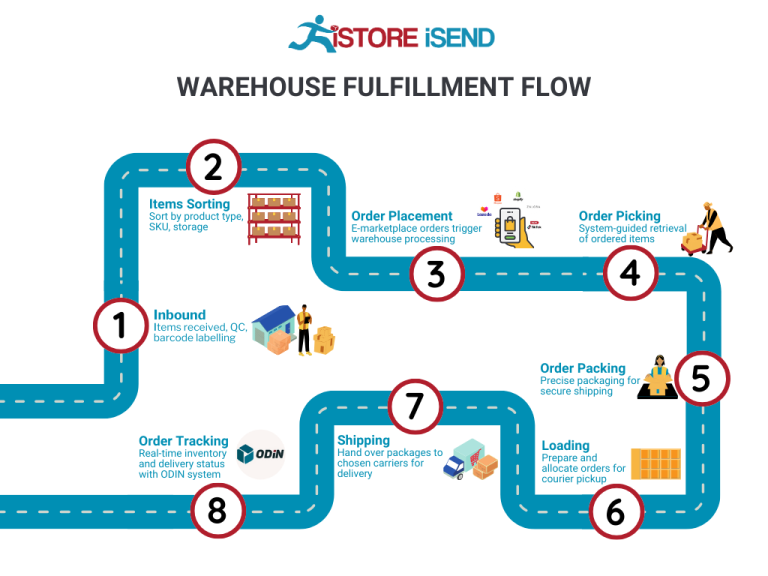
Key Term: Bin Location – This refers to the specific storage location assigned to each SKU within the warehouse. An organized bin location system helps staff quickly find products, reducing picking time and improving overall operational efficiency.
Step 3: Order Picking
Order picking is the process of retrieving items from storage to fulfill customer orders. This can be done using various methods, such as single order picking, where one order is processed at a time, or batch picking, where multiple orders are picked simultaneously to improve efficiency.
Importance: The accuracy of order picking directly impacts customer satisfaction. Incorrect items or quantities can lead to returns, increased costs, and a negative customer experience. Efficient picking processes ensure that orders are filled accurately and promptly, which is crucial for maintaining a competitive edge.
Key Term: Pick Lists – These documents or digital tools outline the items to be retrieved for each order. They guide warehouse staff during the picking process, ensuring that all necessary items are collected and reducing the risk of errors.
Step 4: Order Packing
After items have been picked, the next step is order packing. This involves assembling the products into a shipping box or container, ensuring that they are protected during transit. Packing materials, such as bubble wrap or packing peanuts, may be used to prevent damage.
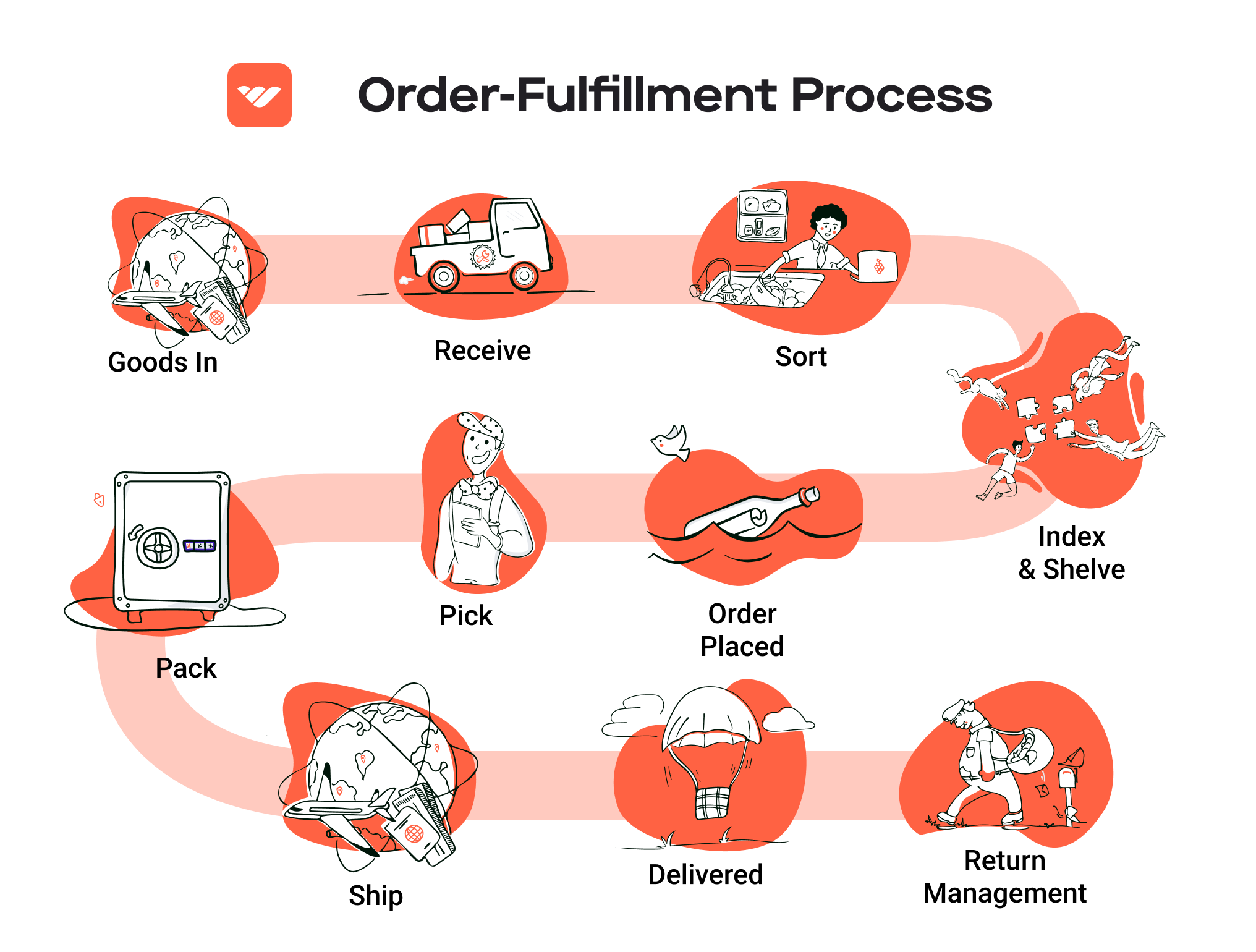
Importance: Effective packing not only protects products during shipping but also enhances the customer’s unboxing experience. A well-packed order can create a positive impression, encouraging repeat business. Additionally, proper packing helps in optimizing shipping costs by minimizing the dimensional weight of packages.
Key Term: Packing Slip – This document is included in the package and lists the items contained within. It serves as a receipt for the customer and helps verify that the correct items were included in the shipment.
Step 5: Shipping & Delivery
The final step in the order fulfillment process is shipping and delivery. Once orders are packed, they are labeled and handed over to shipping carriers for delivery to customers. This step involves selecting the most efficient shipping methods based on factors like cost, delivery speed, and customer preferences.
Importance: Timely shipping is a critical factor in customer satisfaction and loyalty. The ability to provide fast, reliable delivery can differentiate a business in a crowded e-commerce market. Additionally, tracking systems allow customers to monitor their order status, further enhancing their experience.
Key Term: Shipping Label – This is a crucial component of the shipping process, containing important information such as the destination address, tracking number, and return instructions. Accurate labeling is essential for ensuring packages reach their intended recipients without delays.
By understanding and optimizing each step of the order fulfillment process, e-commerce businesses can enhance efficiency, reduce costs, and improve customer satisfaction—key elements for scaling operations successfully.
Comparing Fulfillment Models: In-House vs. 3PL vs. Dropshipping
Fulfillment Model Comparison Table
| Model | Who Handles Inventory | Best For (Business Stage) | Key Advantage | Key Disadvantage |
|---|---|---|---|---|
| In-House Fulfillment | Business itself | Startups to Mid-sized | Full control over inventory and processes | High fixed costs and operational complexity |
| Third-Party Logistics (3PL) | External logistics provider | Growth to Established | Scalability and access to expertise | Less control over operations and potential misalignment of goals |
| Dropshipping | Supplier | Startups and Small Businesses | Low upfront investment and risk | Lower profit margins and reliance on suppliers |
In-House Fulfillment
In-house fulfillment involves managing the entire inventory and order fulfillment process within the business. This model is particularly suitable for startups and mid-sized companies that prioritize control and customization. With in-house fulfillment, businesses can directly oversee every aspect of inventory management, including storage, picking, packing, and shipping. This level of control enables them to tailor the fulfillment process to their brand’s specific needs, ensuring a consistent customer experience. However, the downside is significant: in-house fulfillment often incurs high fixed costs associated with warehousing, staffing, and technology. Additionally, the operational complexity can lead to inefficiencies, especially as order volume increases. Companies may find themselves overwhelmed by logistics challenges, which can detract from their core business activities.
Third-Party Logistics (3PL)
Third-party logistics providers (3PLs) offer a flexible and scalable solution for businesses looking to outsource their fulfillment processes. This model is ideal for companies in the growth stage or those that are well-established and seeking to optimize operations. By partnering with a 3PL, businesses can benefit from the provider’s expertise in logistics, advanced technology, and established infrastructure. This not only allows companies to scale their operations without the burden of managing logistics themselves but also enables them to focus on their core competencies, such as marketing and product development. However, the trade-off is a potential loss of control over fulfillment operations. Communication issues or misalignment of goals between the business and the 3PL can lead to challenges in maintaining service quality and customer satisfaction. Additionally, businesses may face varying service levels and costs depending on the 3PL’s performance.
Dropshipping
Dropshipping is a fulfillment model where the retailer does not keep products in stock but instead transfers customer orders directly to a supplier, who then ships the products to the customer. This model is particularly appealing for startups and small businesses with limited capital, as it requires minimal upfront investment. The primary advantage of dropshipping is the low financial risk; businesses are not burdened with inventory costs, and they can quickly pivot their product offerings based on market demand. However, dropshipping also comes with significant disadvantages, such as lower profit margins due to supplier fees and less control over product quality and shipping times. Retailers depend heavily on their suppliers to fulfill orders accurately and promptly, which can lead to potential customer dissatisfaction if issues arise. Furthermore, the lack of inventory can limit the ability to create unique brand experiences, as products are often generic and commoditized.
Conclusion
Choosing the right fulfillment model is crucial for e-commerce businesses looking to scale effectively. Each model—In-House, 3PL, and Dropshipping—offers distinct advantages and disadvantages that can significantly impact operational efficiency, customer satisfaction, and overall profitability. In-house fulfillment provides full control but at a higher operational cost, while 3PLs offer scalability and expertise but can create challenges in control and alignment. Dropshipping reduces financial risk but may lead to lower profit margins and quality concerns. Understanding these models and aligning them with your business goals and resources will help you optimize your fulfillment strategy as you grow.
A Deep Dive into Amazon FBA: Pros, Cons, and Who It’s For
Understanding Fulfillment by Amazon (FBA)
Fulfillment by Amazon (FBA) is a service provided by Amazon that allows sellers to store their products in Amazon’s fulfillment centers. Amazon then takes care of storage, packaging, and shipping of the products directly to customers. This service is particularly appealing for e-commerce businesses looking to leverage Amazon’s vast logistics network and customer base.
How FBA Works
-
Setup: Sellers create an Amazon seller account and choose to enroll in the FBA program. They then list their products on Amazon, indicating that they want to use FBA.
-
Inventory Shipment: Sellers send their products to Amazon’s designated fulfillment centers. Amazon provides guidelines on how to prepare and package the products to ensure they are ready for storage and shipment.
-
Storage: Once the products arrive at the fulfillment center, they are stored in Amazon’s warehouses until an order is placed. Amazon manages the inventory, ensuring that it is organized and ready for quick retrieval.
-
Order Fulfillment: When a customer places an order for a product that is fulfilled by Amazon, Amazon takes care of the entire fulfillment process. This includes picking the product from the warehouse, packing it, and shipping it to the customer.
-
Customer Service: Amazon also manages customer service for FBA orders, handling inquiries, returns, and refunds on behalf of the seller.
-
Payment and Fees: After the product is sold, Amazon deducts its fees from the sale price before disbursing the remaining funds to the seller.
Pros of Using FBA
1. Prime Eligibility
One of the standout benefits of FBA is that products fulfilled by Amazon are eligible for Amazon Prime. This makes them more attractive to customers who are looking for fast, free shipping options. Prime members often prioritize Prime-eligible products, leading to increased visibility and sales for sellers.
2. Customer Trust
Amazon has built a reputation for reliability and excellent customer service. By utilizing FBA, sellers can leverage this trust. Customers are more likely to purchase products that are fulfilled by Amazon, as they know they will receive their orders promptly and have access to Amazon’s robust return policies.
3. Multi-Channel Fulfillment
FBA isn’t limited to Amazon sales. Sellers can also use FBA to fulfill orders from other sales channels, such as their own websites or other online marketplaces. This multi-channel fulfillment capability allows sellers to streamline their logistics and inventory management.
4. Simplified Logistics
FBA handles all aspects of logistics, including storage, packing, and shipping. This can significantly reduce the operational burden on sellers, allowing them to focus on other areas of their business, such as marketing and product development.
5. Scalability
As businesses grow, FBA can scale with them. Sellers can easily increase their inventory levels and expand their product offerings without needing to invest in additional warehousing or logistics capabilities.
Cons of Using FBA
1. High Fees
FBA comes with various fees, including storage fees, fulfillment fees, and additional charges for long-term storage or returns. These costs can quickly add up, particularly for sellers with low-margin products. Sellers must ensure they factor these fees into their pricing strategy to maintain profitability.
2. Strict Inventory Rules
Amazon has stringent guidelines regarding inventory management. Sellers must adhere to Amazon’s policies on product preparation and packaging, and failure to comply can result in additional fees or inventory being returned to the seller. This can create challenges for businesses that require more flexibility in their inventory management.
3. Commingling Risks
FBA uses a commingling system for inventory, which means that products from different sellers can be stored together. While this can simplify logistics, it also poses risks. If a customer receives a defective product or a product that is not from the original seller, it can harm the seller’s reputation. This is particularly concerning for brands that rely on product quality and customer satisfaction.
4. Limited Control Over Fulfillment
While FBA handles logistics, this also means sellers relinquish some control over how their products are stored, packed, and shipped. Sellers may have specific packaging or branding requirements that Amazon’s standardized process may not accommodate.
5. Potential for Account Suspension
Amazon has strict policies regarding seller performance metrics, such as order defect rates and late shipment rates. If a seller fails to meet these standards, their account can be suspended, leading to lost sales and potential damage to their brand.
Who is FBA Best For?
Fulfillment by Amazon is particularly well-suited for:
- Small to Medium-Sized Businesses: Companies that may not have the resources to manage their own logistics can benefit from the streamlined operations provided by FBA.
- Sellers with High Sales Volume: Businesses that anticipate high sales volumes can leverage FBA’s efficient fulfillment to meet demand without the need for extensive warehousing.
- Brands Looking to Expand: Sellers looking to enter new markets or expand their product lines can use FBA to quickly scale their operations without heavy investments in logistics.
- E-commerce Startups: New businesses can take advantage of Amazon’s vast customer base and fulfillment capabilities to gain traction without needing to establish their own fulfillment operations.
In conclusion, while FBA offers numerous advantages that can help businesses streamline their operations and increase sales, it is essential for sellers to weigh these benefits against the potential downsides. Careful consideration of their specific business needs and goals will help them determine if FBA is the right fulfillment solution for them.
Core Services Offered by Fulfillment Centers
Inventory Management & Warehousing
Effective inventory management and warehousing are the backbone of any successful e-commerce operation. Fulfillment centers provide a centralized location for storing products, which allows businesses to maintain optimal inventory levels and streamline their logistics.
What It Is
Inventory management involves tracking the flow of goods from manufacturers to warehouses and ultimately to customers. This includes maintaining accurate stock counts, forecasting demand, and replenishing inventory as needed. Warehousing refers to the physical storage of products in a fulfillment center, where items are organized for easy access and efficient picking.
Benefits
-
Optimized Stock Levels: By employing sophisticated inventory management systems, fulfillment centers help e-commerce businesses avoid stockouts and overstock situations. This ensures that products are available when customers want them, enhancing customer satisfaction.
-
Cost Efficiency: Centralized warehousing reduces the need for multiple storage locations, which can significantly lower overhead costs. It also minimizes transportation expenses, as goods can be shipped from one location instead of several.
-
Real-Time Visibility: Advanced inventory management systems provide real-time data on stock levels, sales trends, and order statuses. This visibility enables businesses to make informed decisions quickly, allowing them to respond to market changes effectively.
Pick and Pack Services
Pick and pack services refer to the process of selecting products from inventory and preparing them for shipment. This service is crucial for e-commerce businesses that sell a variety of items, as it directly impacts order fulfillment speed and accuracy.
What It Is
The pick and pack process involves receiving an order, locating the products in the warehouse, and packing them securely for shipping. This can include adding packing materials, labeling, and preparing the shipment for delivery.
Benefits
-
Faster Order Fulfillment: Fulfillment centers use optimized picking routes and technology to streamline the pick and pack process, reducing the time it takes to fulfill orders. This leads to quicker shipping times, which is a significant competitive advantage in e-commerce.
-
Improved Accuracy: Fulfillment centers implement quality control measures to minimize picking errors. By ensuring that the correct items are packed for shipment, businesses can enhance customer trust and satisfaction.
-
Scalability: As businesses grow, their order volumes can fluctuate significantly. Fulfillment centers can easily scale their pick and pack services to accommodate seasonal spikes or growth in demand, allowing businesses to focus on scaling their operations without worrying about fulfillment.
Kitting and Assembly
Kitting and assembly services involve preparing products for sale by bundling them together or making final adjustments before shipping. This is particularly useful for businesses that offer multi-item packages or customized products.
What It Is
Kitting refers to the process of grouping multiple items together into a single package or kit, creating a new SKU that can be sold as one unit. Assembly may involve combining components to create a final product, such as putting together a furniture set.
Benefits
-
Enhanced Customer Experience: By providing pre-packaged kits, businesses can create a delightful unboxing experience for customers. This can lead to higher customer satisfaction and increased loyalty.
-
Operational Efficiency: Kitting and assembly performed at fulfillment centers streamline the order fulfillment process. Instead of picking multiple items individually for each order, staff can simply pick the pre-assembled kits, speeding up the shipping process.
-
Increased Average Order Value (AOV): Bundling products together can encourage customers to buy more, as they perceive greater value in purchasing a kit rather than individual items. This can lead to higher sales and improved profitability.
Returns Management (Reverse Logistics)
Returns management, or reverse logistics, refers to the process of handling products that customers return after purchase. This service is crucial for e-commerce businesses, as managing returns effectively can significantly impact customer satisfaction and overall profitability.
What It Is
Returns management encompasses the entire process of receiving returned items, inspecting them, restocking them (if applicable), and handling any necessary refunds or exchanges. Fulfillment centers often have dedicated teams and systems in place to manage this process efficiently.
Benefits
-
Streamlined Returns Process: A well-organized returns management system simplifies the return process for customers, making it easy for them to send items back. This can enhance customer satisfaction and encourage repeat business.
-
Cost Savings: Efficient returns management can reduce the costs associated with handling returns. By quickly assessing returned items, fulfillment centers can determine which products can be restocked and which need to be disposed of or returned to suppliers, minimizing losses.
-
Data Insights: Analyzing return data can provide valuable insights into product performance, customer preferences, and potential issues. This information can inform product development and marketing strategies, helping businesses make data-driven decisions to improve overall operations.
In conclusion, leveraging the core services offered by fulfillment centers—inventory management, pick and pack, kitting and assembly, and returns management—can significantly enhance an e-commerce business’s operational efficiency and customer satisfaction. By outsourcing these critical functions, businesses can focus on growth while ensuring that their logistics are handled professionally and effectively.
How to Choose a Fulfillment Partner: A 6-Point Checklist
Location & Warehouse Network
Why It’s Important:
The geographical location of your fulfillment partner’s warehouses can significantly impact shipping costs and delivery times. A partner with strategically located warehouses allows for faster shipping to your customer base, ultimately enhancing customer satisfaction.
Questions to Ask:
– Where are your warehouses located, and how many do you operate?
– Can you provide coverage maps showing your shipping zones?
– What is the average shipping time from your warehouses to my primary customer locations?
– Do you have plans to expand your warehouse network in the near future?
Technology & Integrations
Why It’s Important:
A robust technological backbone is crucial for seamless operations. The right fulfillment partner should offer advanced inventory management systems, real-time tracking, and easy integrations with your existing e-commerce platforms.
Questions to Ask:
– What technology do you use for inventory management and order processing?
– Can your system integrate with my e-commerce platform (e.g., Shopify, WooCommerce)?
– Do you provide real-time inventory updates and tracking information to customers?
– How often do you update your technology and systems?
Specializations (e.g., Cold Storage, Oversized Items)
Why It’s Important:
Different businesses have different needs. If your products require special handling, such as temperature control for perishables or specific packaging for oversized items, your fulfillment partner must have the capabilities to accommodate these requirements.
Questions to Ask:
– Do you have specialized facilities for cold storage or handling fragile items?
– What protocols do you have in place for managing temperature-sensitive products?
– Can you accommodate oversized or bulky items, and if so, what are the limitations?
– What experience do you have in fulfilling products similar to mine?
Scalability & Capacity
Why It’s Important:
As your business grows, your fulfillment needs will likely change. A good partner should be able to scale operations in line with your growth, whether that means handling increased order volumes or expanding service offerings.
Questions to Ask:
– What is your current capacity for order fulfillment, and how do you handle peak seasons?
– How quickly can you scale up your operations if my order volume increases?
– Do you have contingency plans in place for unexpected spikes in demand?
– Can you provide examples of how you have successfully scaled for other clients?
Pricing and Contracts
Why It’s Important:
Understanding the pricing structure and contract terms is essential for budgeting and ensuring there are no hidden fees. Clear pricing helps you manage costs effectively and avoid unexpected expenses.
Questions to Ask:
– What is your pricing structure (e.g., per order, per item, monthly fees)?
– Are there any additional fees I should be aware of (e.g., storage, handling, shipping)?
– What are the terms of the contract, and is there flexibility for renegotiation?
– Can you provide a detailed breakdown of costs associated with your services?
Customer Support & Reviews
Why It’s Important:
Effective customer support is crucial for resolving issues promptly and maintaining a smooth operation. Additionally, understanding the experiences of other clients can provide valuable insights into the partner’s reliability and service quality.
Questions to Ask:
– What customer support options do you provide (e.g., phone, email, chat)?
– What are your average response times for customer inquiries or issues?
– Can you provide references or case studies from current or previous clients?
– How do you handle disputes or service failures, and what is your process for resolution?
By following this checklist, e-commerce business owners, operations managers, and entrepreneurs can make informed decisions when selecting a fulfillment partner. Each point is designed to guide you through the critical aspects of partnership that will not only enhance your operational efficiency but also contribute to a superior customer experience.
Understanding Fulfillment Pricing: A Breakdown of Common Fees
Initial Setup Fees
When partnering with a third-party logistics provider (3PL) for fulfillment services, you may encounter initial setup fees. These fees are typically charged to cover the costs associated with onboarding your business into their system. This can include the integration of your e-commerce platform with the 3PL’s warehouse management system, setting up your inventory in their system, and configuring any necessary operational processes specific to your business.
The calculation of initial setup fees varies significantly between providers. Some may charge a flat fee, while others might base it on the complexity of your requirements or the number of SKUs being integrated. It’s crucial to discuss these fees upfront and ensure you understand what is included in the setup process.
Receiving Fees
Receiving fees are incurred when your inventory arrives at the fulfillment center. These fees cover the labor costs associated with unloading, inspecting, and storing your products. The receiving process may also involve quality checks to ensure that the products are in good condition and match the purchase order.
Typically, receiving fees are calculated on a per-pallet or per-hour basis, depending on the 3PL’s pricing structure. For instance, some providers may charge a fixed rate for each pallet received, while others might charge based on the time spent processing your shipment. Understanding how receiving fees are structured will help you budget more effectively for your logistics costs.
Storage Fees (per pallet/bin)
Storage fees are charged for the space your inventory occupies within the fulfillment center. These fees can vary based on the size of the storage unit (pallet or bin) and the duration for which your products are stored. Generally, storage fees are calculated on a monthly basis, with costs associated with each pallet or bin your inventory occupies.
It’s important to note that some fulfillment centers may have tiered pricing structures based on the volume of inventory stored. For instance, storing a larger quantity of products could lead to discounted rates. Keep in mind that seasonal fluctuations in inventory levels can also affect your storage costs, so it’s wise to monitor your stock levels and adjust your storage needs accordingly.
Pick & Pack Fees (per item/order)
Pick and pack fees are charged for the labor involved in selecting items from storage and packing them for shipment. This is a critical component of the fulfillment process, as it directly impacts order accuracy and shipping speed.
Typically, pick and pack fees are calculated on a per-item basis, meaning you will pay a fee for each individual item picked and packed for an order. Some providers may offer a flat rate for picking and packing an entire order, while others may charge based on the number of items within that order. Understanding the specifics of how these fees are calculated will help you estimate fulfillment costs as your order volume grows.
Shipping Fees
Shipping fees are the costs associated with transporting your products from the fulfillment center to your customers. These fees can vary widely based on factors such as the shipping method chosen (standard, expedited, etc.), the destination of the shipment, the weight and dimensions of the package, and any additional services required (like tracking or insurance).
Shipping fees are typically calculated based on carrier rates, which can fluctuate based on market conditions. Many 3PLs have established relationships with carriers, allowing them to negotiate competitive rates that may be passed on to you. It’s essential to understand the shipping options available through your provider and how they affect your overall fulfillment costs.
Tips for Getting an Accurate Quote
To secure an accurate quote from a fulfillment provider, consider the following tips:
-
Be Transparent About Your Needs: Clearly communicate your business model, expected order volume, and specific fulfillment requirements. This will help the provider tailor their services and pricing to your needs.
-
Request Itemized Pricing: Ask for a detailed breakdown of all potential fees, including initial setup, receiving, storage, pick and pack, and shipping. This transparency will help you avoid unexpected costs.
-
Inquire About Discounts: Many providers offer discounts based on volume or long-term contracts. Be sure to ask about any potential savings opportunities.
-
Review Service Level Agreements (SLAs): Understand the service expectations outlined in the SLA, as these can impact your fulfillment costs and overall customer satisfaction.
-
Compare Multiple Providers: Don’t settle for the first quote you receive. Compare offers from multiple fulfillment centers to find the best fit for your business.
By taking the time to understand these common fulfillment fees and following these tips, you can make more informed decisions that support your business’s growth and efficiency in the competitive e-commerce landscape.
Frequently Asked Questions (FAQs) about Fulfillment
1. What is fulfillment kitting?
Fulfillment kitting is the process of assembling multiple products into a single package or kit before an order is placed. This can involve gathering different items, packaging them together, and preparing them for shipment as one cohesive unit. This approach streamlines the fulfillment process by allowing for quicker order processing and enhanced customer experience.
2. How does the kitting process work?
The kitting process typically involves several steps:
1. Planning: Identify which products will be included in the kit.
2. Assembly: Gather the necessary items, which may include unwrapping, inspecting, and labeling.
3. Packaging: Place the items into custom boxes or containers.
4. Storage: Store the completed kits in a designated location for efficient picking when orders come in.
5. Fulfillment: When an order is received, the kit is picked as a single item, reducing processing time.
3. What are the benefits of using kitting services?
Kitting services offer several advantages:
– Improved Efficiency: By pre-assembling kits, fulfillment centers can reduce picking time and errors.
– Faster Shipping: Kits can be shipped faster since they are already packaged and ready to go.
– Enhanced Customer Experience: A well-designed kit can provide a more delightful unboxing experience.
– Space Optimization: Storing kits in one location simplifies inventory management and reduces warehouse space usage.
– Increased Revenue: Bundling products can encourage customers to purchase more due to perceived value.
4. How does kitting differ from bundling?
While both kitting and bundling involve grouping products, they differ in the fulfillment process. Kitting involves pre-assembling items into a single SKU before an order is placed, allowing for faster fulfillment. Bundling, on the other hand, typically involves selecting individual items from separate locations once an order is received, which can take longer and may lead to errors.
5. What is the difference between a warehouse and a fulfillment center?
A warehouse primarily serves as a storage space for inventory, while a fulfillment center is designed to handle the entire process of order processing, including picking, packing, and shipping. Fulfillment centers often incorporate technology and processes that streamline logistics, making them better suited for e-commerce operations.
6. What is a 3PL, and how do they relate to kitting services?
A Third-Party Logistics provider (3PL) is a company that manages logistics and supply chain functions for businesses. 3PLs can offer kitting services as part of their fulfillment solutions, allowing e-commerce businesses to outsource the assembly and packaging of kits, thus freeing up resources and improving operational efficiency.
7. How much do fulfillment kitting services cost?
The cost of fulfillment kitting services can vary widely based on factors such as the complexity of the kitting process, the volume of kits being assembled, and the specific 3PL provider you choose. Generally, you can expect to pay for both the kitting labor and the storage of the kits. It’s advisable to request quotes from multiple providers to find a cost-effective solution that meets your needs.
8. Can I customize kits for special promotions or seasons?
Yes, many 3PL providers offer flexible kitting solutions that allow businesses to customize kits for seasonal promotions, holidays, or special events. This customization can enhance customer engagement and drive sales by providing tailored offerings that meet specific consumer demands.
9. What types of products are best suited for kitting?
Products that benefit most from kitting include those that can be easily grouped together, such as subscription boxes, gift sets, or promotional bundles. Additionally, items that require special packaging or assembly, like custom kits for events, also lend themselves well to kitting services.
10. How can I get started with kitting services for my e-commerce business?
To get started with kitting services, first assess your product offerings and determine which items could be bundled into kits. Next, research and reach out to 3PL providers that offer kitting services, discussing your needs and any customization options. Finally, collaborate with the chosen provider to set up the kitting process, ensuring it aligns with your fulfillment strategy and operational goals.
Conclusion: Is Outsourcing Fulfillment the Right Move for Your Business?
Evaluating the Benefits of Outsourcing Fulfillment
Outsourcing your fulfillment process can be a transformative decision for your e-commerce business. By leveraging a third-party fulfillment service, you stand to gain significant advantages that can propel your operations to the next level. One of the most immediate benefits is time savings. Fulfillment services streamline the entire process, from inventory management to order dispatch, allowing you to focus on core business activities like marketing and product development. This efficiency can lead to faster shipping times, enhancing customer satisfaction and loyalty.
Scalability is another compelling reason to consider outsourcing. As your business grows, so do the complexities of managing logistics. A proficient fulfillment partner can seamlessly scale operations to meet fluctuating demand, whether it’s during peak seasons or unexpected surges in orders. This flexibility means you can expand your product offerings or enter new markets without the burden of additional warehousing or labor costs.
Moreover, fulfillment services bring specialized expertise that can elevate your operational efficiency. These providers often have advanced technology, optimized processes, and experienced staff dedicated to ensuring accuracy and speed. This not only improves your order fulfillment rates but also minimizes costly errors that can arise from in-house management.
However, choosing the right fulfillment partner is crucial for your growth trajectory. A misaligned partner can lead to operational bottlenecks and customer dissatisfaction. Therefore, take the time to research potential partners, assess their capabilities, and ensure they align with your business goals.
Call to Action
To determine if outsourcing fulfillment is the right move for your business, consider conducting an audit of your current shipping process. Evaluate your time expenditures, costs, and customer feedback. This analysis will help you make an informed decision about whether a fulfillment partner could enhance your operational efficiency and support your growth ambitions.
Important Disclaimer
⚠️ Important Disclaimer
The information in this guide is for educational purposes. Fulfillment services, pricing, and platform features change frequently. Always conduct your own due diligence and consult with providers directly before making business decisions.
